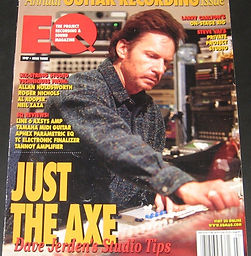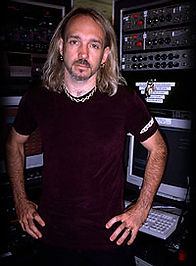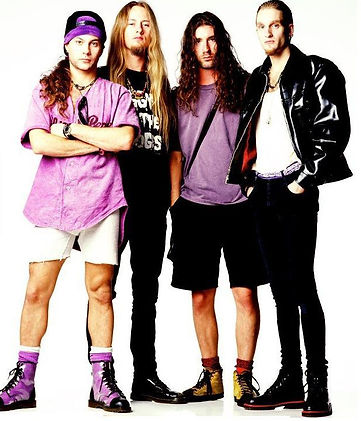
The band tried by that time to deny once and again any association with the Grunge concept. The metal in their own words was a genre much closer to what they were doing back then. The music of Alice in Chains actually was much more elaborated than their contemporaries in the Seattle scene. While Kurt Cobain opted for a more sabbath -punk style, Jerry Cantrell felt comfortable becoming a guitarist of exceptional features with extraordinary composition skills. Pearl Jam was also exploding worldwide at that time , but their music was part of a more classic Hard Rock style. Soundgarden might be considered a bit more in line with the path of Alice in Chains, but still lacked the originality that Staley and co. provoked to the most discerning listeners and makes them to this day worthy of perhaps the greatest prize a band can get , creating a unique style .
The Anguish, despair and oppression that the chains in motion provoke
DIRT
The second album by Alice in Chains is perhaps the defining masterpiece, despite themselves, the grunge movement of the 90s, positioning them as icons of the Generation X. Distressing lyrics, huge riffs with a touch of dry, thick distortion plus the Layne Staley voice explosion, the angry angel who self inflicted pain and darkness with every note his privileged voice threw, make DIRT, an album as disturbing as perfect, the desired combination for a whole brood of hopeless youngsters that were enmity with life.

Facelift, the debut album of the band, despite a slow start, ended up being a great success mainly due to the hit single "Man in the Box" and a sound that, although incipient, was completely different from what sounded at the time , a sound that could not be classified as metal or as the "Seattle sound" as it was known in those years.
Dirt is a deepening of what happened in Facelift but in a sublime level, full of dark emotion in lyric and music, primarily related to drug use, mainly heroin, which had already become a living hell for Layne since his initiation in the "Van Halen" tour. According to words of Yanni "Johnny" Bacolas personal friend of Layne in "Grunge is dead": “[Layne] told me that he started his “abuse”[during] the Van Halen tour. That’s when he was introduced to heroin. I asked him, “How did this happen?” His exact words were, “Johnny, when [I] took that first hit, for the first time in my life, I got on my knees, and I thanked God for feeling good.” From there, it just didn’t stop.
But by that time, not just Layne was trapped in drug addiction, the other three members also fought their own personal battles, Jerry was immersed into cocaine, Sean deeply alcoholic and Mike also started on heroin, most likely by Layne lifestyle. So then, the creative period to reach Dirt, places us in front of band immersed into hard addictions that have likely contributed to make of Dirt an album with such brutal honesty as rarely seen in the history of music.
The acclaimed Dave Jerden was the producer chosen by the management of the band to perform the task in the study. He was the same as Facelift, and responsible for historic albums for artists of world level as Talking Heads, Frank Zappa, Red Hot Chili Peppers, Rolling Stones, Jane's Addiction, among others. Jerden, had a very results-oriented temper so he incited the band members to buy the best equipment that was in the market in order to get the best of each of them. This rather close relationship with the band provoked him some degree of controversy with the manager, Susan Silver, who didn´t want to be out of the budget allocated for Columbia for the recording of the album
But another important part in the sound made in Dirt, is the recently deceased engineer Bryan Carlstrom (1962-2013). Alongside Jerden were one of the most prolific and most visionary pairs in the music industry.


The acclaimed Dave Jerden was the producer chosen by the management of the band to perform the task in the study.
But another important part in the sound made in Dirt, is the recently deceased engineer Bryan Carlstrom (1962-2013)
The sessions took place mainly in the city of Los Angeles, in the studio "One on One" the exact day (April 29, 1992) in which the verdict of the Rodney King case was delivered and the city of Los Angeles erupted into chaos and violence, giving a heavier vibe to the album. Would? was recorded at London Bridge Studio in Seattle to be included in the soundtrack of Singles movie and Fear the Voices, which ultimately was not included on the album but in the later Box Set "Music Bank", was recorded at Eldorado Recording Studios in Burbank, California.
The album took about 5 months to be completed and was finally released a in September 29th, 1992. But neither the band nor the public were ready for an album of the features of Dirt ...
Although Jerry Cantrell is mentioned in many biographies as the creative genius behind the composition of the catalog of Alice in Chains, in Dirt, the Cantrell-Staley duo shares almost 50% credit for the lyrics of this work (Rain When I Die, Sickman, Junkhead, Dirt, Godsmack, Hate to Feel Angry Chair) creating a unique moment in time where these masters of the dark hold a manifest of self-destruction, self inflicted pain, self-pity, denial and madness who fit perfect with the features the north american youth had by those years and that was extended to the whole world. Distress, lack of opportunities, broken and dysfunctional homes, uncertain future, drugs were the concepts that made Dirt, the soundtrack of a generation and continue to this day producing chills between the ones who lived that time.
Dirt has its own voice and soul, a heartbreaking voice and a dark soul. It is considered by many as a concept album for his outspoken reference to use, dependence and self-destruction related to heroin and addictions in general. The sequence in the second half of the album that starts with Junkhead and ends with Angry Chair is almost like a Via Crucis, which we observe our Christ Addict defiantly, urging us to follow him (What's my drug of Choice / Well, what have you got? / I do not go broke / and I do it a lot-Junkhead) through recognition of the hard addiction (You have the talent to / make me feel like Dirt / and you, you use your / Talent to dig me under / and cover me with Dirt-Dirt) and leading to the vision of the craziness of our fallen hero (See myself molded in clay / stares at me, yeah I'm afraid / Changing the shape of his face-Angry Chair)

Cantrell said in an interview about the sequence of heroin: “Those five songs on the second side, from “Junkhead” to “Angry Chair,” are in sequence because it tells a story. It starts out with a really young, naive attitude in “Junkhead,” like drugs are great, sex is great, rock and roll, yeah! Then as it progresses, there’s a little bit of realization of what it’s about”
The explosion of Nirvana and Nevermind created a kind of gossip journalism focused on the Seattle scene, Alice in Chains was one of the most affected bands by this new journalism that appeared precisely because of these songs spoke explicitly of the use and abuse of substances. During those years, the management of the band and the band itself tried to divert attention of the songs on Dirt and the actual state of Layne, however more than 20 years after the release of the album, the album shows even a much more brutal aspect that in that time, because all the stuff was true. The facts are undeniable and the loss of Layne by this terrible disease gives notice of it.

But Dirt lyrics also covered other topics not related to drugs. Them Bones, is a song that addresses the issue of mortality and panic that causes us to think that one day everything will be finished for each of us (I feel so alone Gonna end up a / big ole pile a them bones). We can see the majesty of Cantrell's guitar riff with an expansive texture that goes back and forth in a rhythm in 7/8 only comparable to the innovation of Pink Floyd Money, also written in 7/8 rythm.
Note that this first track shows of a remarkable difference with Facelift: the perfect combination of vocal harmonies between Staley and Cantrell . The combination between the Layne 's engine voice combined with Cantrell 's voice smoothness make each one of the songs of this album have an even more spooky tone and would become the trademark of the band thereafter. Down in a hole with its fine melodies walks through the roads of the loss of true love, and how that loss haunts you for the rest of your days and becomes an infected sore that does not heal (Bury Me Softly In this womb / I give this part of me for you / sand rains down and here I sit / Holding rare flowers in a tomb ... in bloom) . Rooster is a therapeutic song for Jerry Cantrell , something like the end of a cycle with his father who arrived back from Vietnam transformed completely into another man. Alcoholism , domestic violence, distance towards his children , secrecy are some of the consequences that drags Jerry Cantrell father in exchange for serving his country as a soldier and be an eyewitness to the horrors of war. Jerry writes about his father in first person trying somehow to get inside his father´s boots and reestablish a bond that was broken for a long time (Ain´t found a way to kill me yet / eyes burn with stinging sweat / seems every path leads me to nowhere/ wife and kids household pet/ army green was no safe bet). A main riff that is triggered like a thunder, plus the huge drums by Sean Kinney make this track one of the heavier songs on the album.
Rain When I Die and Would? show the mastery of Mike Starr as the owner of the 4 strings, creating bass lines that are in the DNA of any that claims to be a hard rock fan. In a way it is ironic that the album ends with a song just like Would?, A piece that is mainly based on repentance, and composed especially for Andy Wood, Mother Love Bone leader and martyr of the substance abuse, especially loved by all his contemporaries in the Seattle scene for his good humor and love he showed for life. Ironically in a band especially struck by the same disease, with 2 of its members who have already left as Andy.
Dirt is a damned album. It is extremely difficult to think that may be another Alice in Chains album with the specific weight of Dirt. It is also difficult to think that an album of this nature could be released in our time (2014) because it is so violent, brutal, raw and honest in its music and lyrics. It would definitely be censored by a major label. Alice in Chains was not a band of poses, where a singer talks about how hard is to live on the streets and yet you know that those lyrics were probably written in the comfort of his home. That is the merit and distressing of Dirt. The pain expressed in this album is real in every minute. An honest and devastatin album to each of its members that has become a classic and a must at the expense of dirt, putrefaction and blood.
Article and translation by: Pablo Schulz
